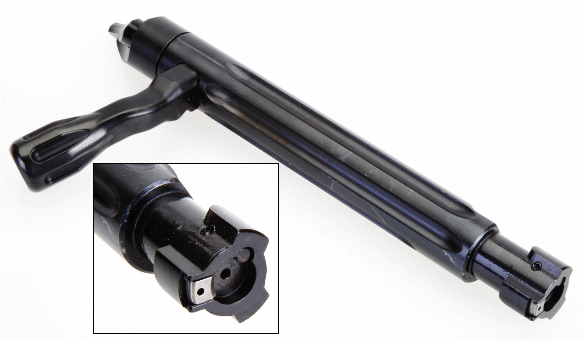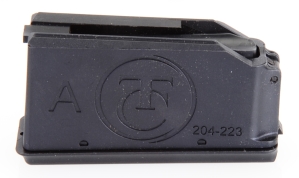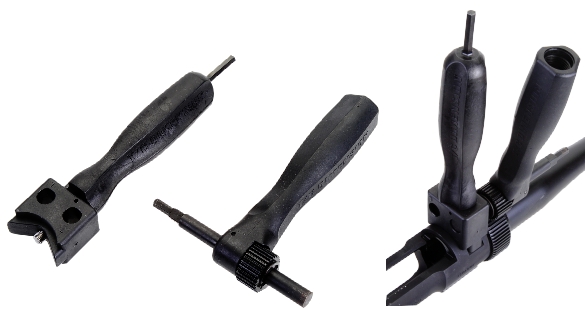 If you’re a person who takes photography seriously, you probably own a systems camera; interchangeable lenses, manual control, multiple format capability, accessory view finders, etc… Well, that’s sort of what the Dimension offers a firearm enthusiast, a systems firearm that can be tailored to many mainstream applications. This is something that T/C Arms has done well over the years, dating back to 1967 and the original T/C Contender.*
If you’re a person who takes photography seriously, you probably own a systems camera; interchangeable lenses, manual control, multiple format capability, accessory view finders, etc… Well, that’s sort of what the Dimension offers a firearm enthusiast, a systems firearm that can be tailored to many mainstream applications. This is something that T/C Arms has done well over the years, dating back to 1967 and the original T/C Contender.*
The central feature of the Dimension is that it can easily, and cost effectively, be converted to many popular chambers from the 204 Ruger to the 300 Winchester Magnum. This modular system is Thompson/Center’s LOC™ system; Locking Optimized Components. Matching one of four available LOC™ bolt types, identified with an “A”, “B”, “C”, or “D” designation, with one of ten compatible LOC™ barrel, magazine and magazine housing sets, configures the Dimension to shoot:
| LOC™ Bolt |
LOC™ Barrel Kits |
|||
| A | 204 Ruger | 223 Rem | – | – |
| B | 22-250 Rem | 243 Win | 7mm-08 Rem | 308 Win |
| C | 270 Win | 30-06 Spgfld | – | – |
| D | 7mm Rem Mag | 300 Win Mag | – | – |
Through discount retail, a complete Dimension rifle can be purchased for approximately $589. A LOC™ conversion barrel kit can be purchased for approximately $188. Moving to a different LOC™ bolt designation would add roughly $120 more. Far less expensive than buying a second firearm and about half the price of a barrel change by a qualified gunsmith.
|
||||||||||||||||||||||||||||||||||||||||||||||||
Looking more closely at the Dimension, it is apparent that it is so much more than just a rifle with switch barrel capability, although, some of the details have taken a back seat to a switch barrel marketing focus and the presentation of the barrel changing process. I know we live in a world that revolves around Tweets, video shorthand and catch phrases, but my brain likes to be fed details and specifications.
As an example, the Dimension has a three lug bolt that yields a shallow 60º lift. Subsequently, the bolt handle will clear larger scope eyepieces, even with a relatively low ring/mount height. The bolt stroke varies appropriately with cartridge selection (i.e. the stroke for the 308 Winchester is shorter than that of the 300 Win Mag). Between the shallow bolt handle lift and minimized stroke, the bolt throw is always the shortest possible.

 The bolt’s body major diameter is the same as the locking lug diameter. It has three lugs and a recessed bold face. The bottom side of the bolt is scalloped where it rides over the staged round in the rifle’s center feed magazine. I’d hazard a guess that the combination of fluted and scalloped bolt body cuts down on bolt drag significantly. The action is smooth.
The bolt’s body major diameter is the same as the locking lug diameter. It has three lugs and a recessed bold face. The bottom side of the bolt is scalloped where it rides over the staged round in the rifle’s center feed magazine. I’d hazard a guess that the combination of fluted and scalloped bolt body cuts down on bolt drag significantly. The action is smooth.
The Dimension’s magazine holds three rounds, which is a bit shy of the five rounds capacity of most bolt action rifles chambered for the 223 Remington. Part of this reduction comes from the Dimension’s use of straight up and down, center feed magazine design as opposed to a less reliable staggered box magazine that utilizes lateral space more efficiently. However, Dimension magazines, for all cartridge types, have a capacity of three rounds… including belted magnums, so I haven’t quite sorted out why the 223 Remington is a three shot proposition.
Nifty engineering…
The Dimension utilizes the Thomson/Center Arms R5 rifling feature. The concept is that 5 lands and grooves, versus six, place a groove opposite a land, which causes less bullet distortion. Additionally, the sides of the lands are cut at 65º rather than a traditional 90º, which is intended to reduce fouling.
The Dimension’s bolt head recesses into the barrel where its locking lugs engage when the bolt is closed, unlike more traditional receivers that house the lug seats in the rifle’s receiver. Within the T/C Arm’s scheme of things, it is easier to hold all assemblies in consistent longitudinal alignment and to keep the breech face square to the bore and a cartridge case well supported. Headspace dimension is controlled by the fit of the bolt to the barrel, not the barrel to the receiver.

The Dimension has a 7075 aluminum alloy, cylindrical receiver that weighs only 12 ounces. It is readily available in right and left hand versions. The receiver doesn’t do much more than provide a mounting point for the trigger and guide the bolt when ejecting empty casings and feeding live rounds.
Proprietary tools…
The proprietary tools included with each complete dimension represent a smart move on T/C Arms’ part. They represent everything needed to swap barrels and to assemble/disassemble the balance of the rifle correctly. Their inclusion goes a long ways toward assuring a Dimension owner will do the job right and with a minimum of grief and T/C Arms won’t see warranty returns where the owner attempted use of a kitchen whisk and propane torch for barrel removal.

Left to right – The LOC Leverage Tool serves as a hex driver for loosening and/or removing scope mount and stock screws and as a fixture that anchors the receiver and locates the Torque Tool when changing out a barrel. The Torque Tool is a torque wrench that is used to tighten stock fasteners and to tighten or loosen the barrel’s Torque Collar when changing out barrels. Far right – the Torque Collar that secures the barrel is a ring nut with external teeth. The torque wrench has a smaller diameter wheel, with matching teeth, that engages the Torque Collar on the barrel and is held in proper alignment by the LOC Lever Tool. The combination provides a mechanical advantage for tightening or loosening the Torque Collar and a fixed clicker torque wrench function to assure proper installation.
And another thing…
The barreled action is secured to the stock at two points, arrows, aluminum pad aft and V Block front. The fasteners installed/removed with the LOC Leverage tool end and torqued with the Torque Tool… makes sense. The barrel is a floater with approximately a 1/4″ that runs the length of the forearm. And to think of all of those years of nit picking inletting and glass bedding…

The stock’s comb is high enough to actually provide support while shooting through a scope and the cheek piece is ambidextrous. I’d imagine that the latter means a common tool for manufacturing left and right hand stocks. The spacers between the stock and the recoil pad allows for pull length adjustment, 12.5″ – 13.5″. The raised traction pads work well with bare or gloved hands in very cold and warm weather. Living in Maine, it was easy to test for both conditions within the same morning.
Mercifully… End of part 1
I know the rifle has been flogged elsewhere, ad nauseam, but I needed to work through the details myself before forming any opinions and in preparation for live fire.
In general, I like the design of the rifle. It offers shooting comfort, accuracy and flexibility and at an attractive price. Its modern look is a good one. Form can follow function with aesthetic appeal. The switch barrel feature holds economic appeal and it is convenient for a hunter who travels or is working from a remote camp. It dawned on me that with the level of performance the Dimension promises, it delivers more than an R8 Blaser, at about 15% of the composite stocked Blaser’s current prices.

Thompson/ Center took a step forward by using modern materials in a non-traditional fashion. They didn’t try to disguise the composite stock by shaping it into a walnut stock’s classic geometry and fit. They pushed up the Dimension’s comb for scope use, they tossed in spacers to make pull adjustable and they pulled the forearm down away from the barrel to prevent it from doing odd things to barrel harmonics. They took better advantage of the materials they selected for the sake of consistent field accuracy. Looking forward to Part 2 to see how the effort worked out.
*Standard Catalog of Firearms – Schwing
Thompson/Center’s Dimension Part 1
Thompson/Center’s Dimension Part 2

Email Notification